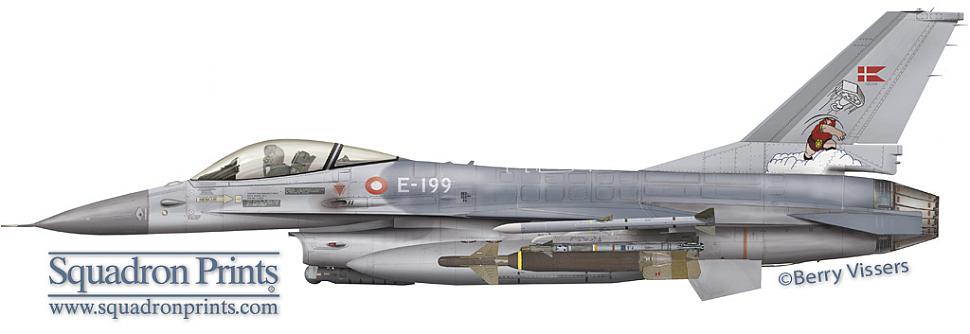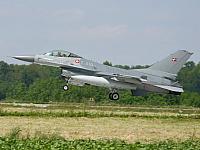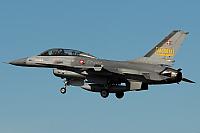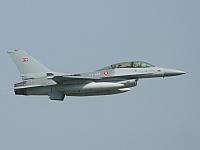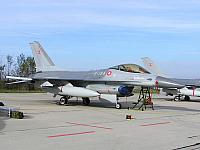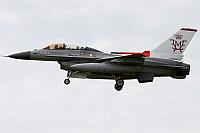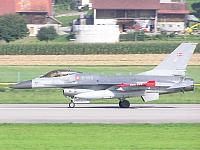 |
Eskadrille 727 ( RDAF)" Craven" |
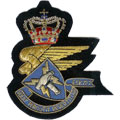 |
Esk 727 " Craven" ( RDAF) | |||
| Status: |
Active
|
|||
| Version: | F-16A/B block 20 MLU | |||
| Role: | Multirole, Training | |||
| Tailband: | N/A | |||
| Motto: | Volat Percutit Revertitur (Winged to Strike hard to Return) | |||
| Badge: | The hammer of Thor on a blue shield. | |||
F-16 History
Esk 727 was the first Danish squadron to receive the F-16 fighter. From mid 1980 the squadron started to receive the aircraft from the Belgian SABCA factory, where the Danish aircraft of the first batch were being produced. It was declared fully operational on August 26th, 1981. The first task of the squadron was to train all future F-16 pilots of the Skrydstrup based units. Secondly it trained for a traditional ground attack role replacing the vintage F-100 Super Sabre in this role.
When both Esk 727 and 730 were transitioned on the F-16, the squadron disposed of its training task to Esk 723, where it stayed permanently until the disbandment of that squadron in 2001, when the task returned to the 727th.
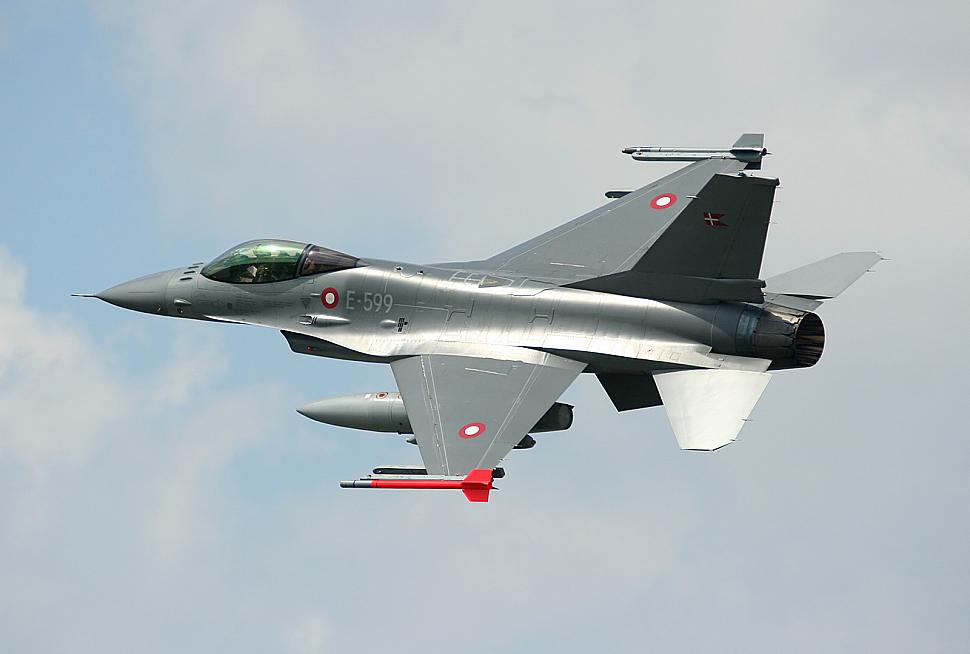
One of the features of the Danish F-16s was a 450W search light on the port side of the aircraft. This was the same light as was installed on the Norwegian F-16s and also later on the F-16ADF and Portuguese vipers to identify aircraft during nightly intercepts. This search light was installed during the initial production of the airframes.
Although being the first squadron to receive the F-16, it was the last Danish F-16 unit to convert to the MLU version in 2003. Enhancements in the use of modern air-to-air missiles like the AMRAAM missile and the use of new air-to-ground weapons as the AGM-65 missile enlarged to operational envelope of the F-16 drastically.
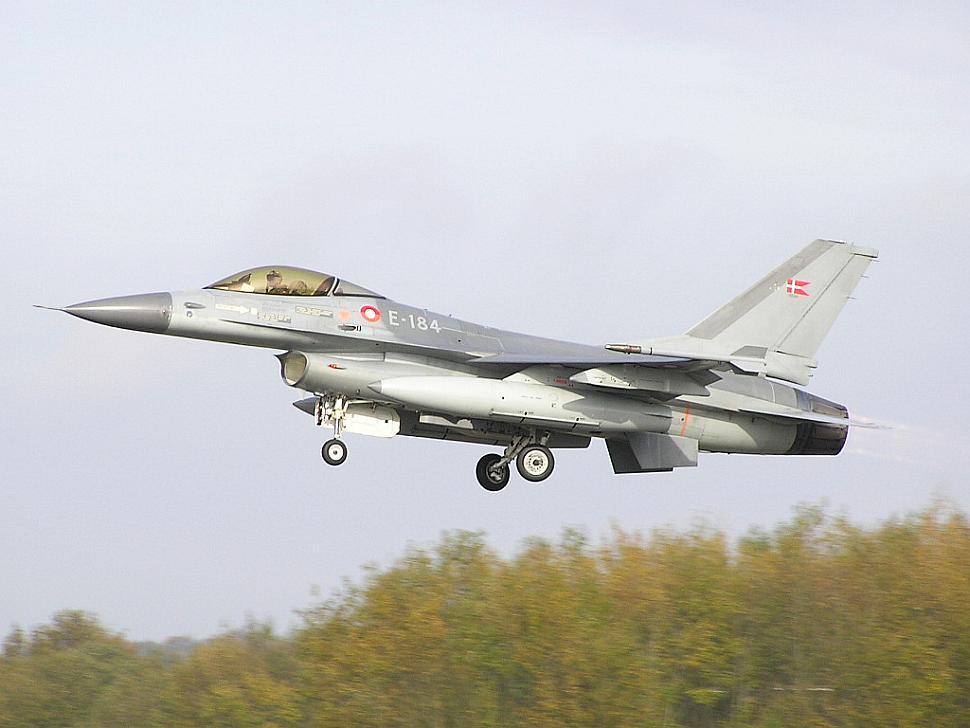
Aircraft Markings History
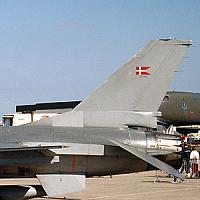
The Danish squadrons have never worn specific unit markings, except for temporary occasions. The tail markings consist of only a Danish flag in the middle. Unit markings are much more commonly found on the engine air intake.
Unit History
- 1952: Activation of the squadron in Karup
- 1952: F-84G 'Thunderjet'
- 1959: F-100D/F 'Super Sabre'
- 1974: F-100D/F 'Super Sabre' (Skrydstrup)
- 1980: F-16A/B 'Fighting Falcon'
- 2003: F-16AM/BM 'Fighting Falcon'
Deployments
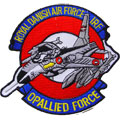 |
' Allied Force' |
| Grazzanise AB, Italy (March 23rd, 1999 to June 10th, 1999) | |
| Operation 'Allied Force' was the codename for the almost three month long air strikes against Serbia. It was the first time after WWII that Denmark deployed fighters into operation. The aircraft were tasked with CAP mission since they didn’t send their new MLU aircraft. | |
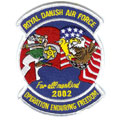 |
' Enduring Freedom' |
| Manas AB, Kyrgyzstan (October 1st, 2002 to September 30th, 2003) | |
| Operation 'Enduring Freedom' was initiated after the 9/11 attacks on the US. In Afghanistan this operation is aimed at fighting the remains of the Taliban which are still present in-country. | |
 |
' Air Policing Baltic States' |
| Siauliai AB, Lithuania (July 1st, 2004 to October 29th, 2004) | |
| This operation started when Lithuania, Estonia and Latvia joined NATO. These countries don't have fighters themselves and rely upon NATO for there air coverage. In a three-month rotation, Belgian, Danish, Norwegian and Dutch F-16s will patrol the skies over the Baltic States. | |
 |
' Air Policing Baltic States' |
| Siauliai AB, Lithuania (January 2nd, 2009 to April 30th, 2009) | |
| This is the second deployment of Danish F-16s to the Baltic. This operation started when Lithuania, Estonia and Latvia joined NATO. These countries don't have fighters themselves and rely upon NATO for there air coverage. | |
 |
' Iceland Air Policing and Surveillance' |
| Keflavik AB, Iceland (March 9th, 2009 to April 1st, 2009) | |
| After the USAF left Keflavik in September of 2006, they left a gap in Icelandic air defence. Since Russia resumed their long-range bomberflights, Iceland asked NATO to step in to fill this gap. Different NATO countries will rotate in and out of Keflavik to perform these air patrols. | |
 |
' Iceland Air Policing and Surveillance' |
| Keflavik AB, Iceland (March 8th, 2010 to March 29th, 2010) | |
| For the second censequitive year the RDAF takes responsibility to cover the airspace of Iceland. This time the deployment was for only 3 weeks. | |
 |
' Odyssey Dawn / Unified Protector' |
| Sigonella AB, Italy (March 23rd, 2011 to October 31st, 2011) | |
| Denmark assigned a total of 6 F-16s to this campaign right after the start on March 23rd. | |
|
|
' Air Policing Baltic States' |
| Siauliai AB, Lithuania (September 2nd, 2011 to January 3rd, 2012) | |
| This marks the third deployment of Danish F-16s to the Baltic. This operation started when Lithuania, Estonia and Latvia joined NATO. These countries don't have fighters themselves and rely upon NATO for there air coverage. | |
|
|
' Air Policing Baltic States' |
| Siauliai AB, Lithuania (January 3rd, 2013 to April 29th, 2013) | |
| Another round of policing the Baltic States was inserted in the Danish rotational cycle. | |
|
|
' Air Policing Baltic States' |
| Ämari AB, Estonia (April 28th, 2014 to August 31st, 2014) | |
| With the hightened tensions in Ukrain, NATO decided to also beef up its presence in some other areas close to the Russian or Ukrainian border. This led to some nations deploying fighters to the Baltics simultaniously and in higher number than normal. This is the first deployment to Ämari AB in Estonia. |
F-16 Airframe Inventory
- All Esk 727 F-16s in our F-16 Aircraft Database (past and current aircraft)
- Current Esk 727 F-16s in our F-16 Aircraft Database
Photos
Please use this form to add any list any error or omissions you find in the above text.
Note: your comments will be displayed immediately on this page. If you wish to send a private comment to the webmasters, please use the Contact Us link.

